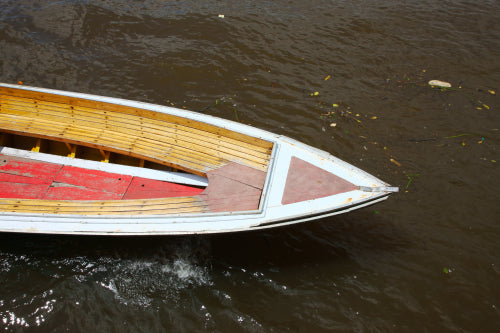Quick Listen:
When it comes to decking materials for boats, the decision can be overwhelming, especially for those who are not familiar with the various options available. Traditional materials like teak and vinyl have been popular choices for years, but in recent times, EVA foam decking has gained significant traction among boat owners. EVA (Ethylene-Vinyl Acetate) foam is a modern, synthetic material that is increasingly being used as an alternative to traditional decking materials. In this comprehensive comparison, we will dive into the advantages and drawbacks of EVA foam decking compared to more conventional materials like teak and vinyl. We'll also examine crucial factors such as durability, comfort, maintenance, cost, and overall performance to help you make an informed decision when choosing the best decking material for your boat.
1. Durability: EVA Foam vs. Traditional Decking Materials
Durability is one of the most important considerations when choosing a decking material for a boat. After all, your boat is exposed to harsh environmental conditions, including saltwater, sunlight, and constant foot traffic.
EVA Foam:
EVA foam decking is known for its excellent durability. It is resistant to the elements, including UV rays, saltwater, and high temperatures. Unlike wood or vinyl, EVA foam does not warp, crack, or splinter over time, making it a long-lasting option for boat decks. Additionally, EVA foam is resistant to mildew and mold, which is particularly beneficial in marine environments. The non-porous nature of EVA foam means it is less prone to damage from exposure to water.
Traditional Boat Decking (Teak and Vinyl):
Teak Decking: Teak is often considered the gold standard for traditional boat decking. It's known for its timeless aesthetic, exceptional strength, and natural resistance to water. However, teak requires regular maintenance, such as sanding, sealing, and oiling, to keep it in top condition. Over time, it can show signs of wear, including fading and cracking, especially if not cared for properly. Despite its durability, teak is not impervious to the effects of saltwater, sunlight, and mildew.
Vinyl Decking: Vinyl decking offers good resistance to UV rays and water, making it another solid choice for marine environments. While vinyl is relatively low-maintenance compared to teak, it is more prone to wear and tear over time. It can crack or peel when exposed to extreme weather conditions or frequent heavy traffic. However, compared to teak, vinyl decking tends to have a longer lifespan with less maintenance.
Verdict: While traditional decking materials like teak and vinyl are durable, EVA foam generally outperforms them in terms of longevity and resistance to the elements. EVA foam's ability to withstand wear, tear, and environmental exposure without deteriorating makes it a great option for long-term durability.
2. Comfort: EVA Foam vs. Traditional Decking Materials
Comfort is another key factor when selecting decking for your boat. You'll want a material that not only provides an attractive surface but also offers comfort underfoot, especially during long boating trips.
EVA Foam:
One of the standout features of EVA foam decking is its comfort. The soft, cushioned surface provides excellent shock absorption, making it gentler on your feet compared to harder materials like teak or vinyl. This added comfort is especially beneficial when walking barefoot on the deck or standing for extended periods. EVA foam also tends to stay cooler underfoot, even in direct sunlight, unlike traditional decking which can heat up quickly.
Traditional Boat Decking (Teak and Vinyl):
Teak Decking: Teak, while durable and attractive, is a hard surface that doesn't offer the same level of comfort as EVA foam. Walking on a teak deck for extended periods may lead to foot fatigue, particularly if the deck gets too hot under the sun. Additionally, teak decks can become slippery when wet, which can be dangerous.
Vinyl Decking: Vinyl is generally softer than teak, but it does not provide the same cushioned feel as EVA foam. While vinyl may stay cooler than teak, it still tends to get hot in direct sunlight. Like teak, vinyl can become slippery when wet, making it less comfortable and safe compared to EVA foam.
Verdict: EVA foam is the clear winner when it comes to comfort. Its cushioned surface, temperature regulation, and slip resistance provide a much more comfortable experience, particularly for those who spend extended time on their boat.
3. Maintenance: EVA Foam vs. Traditional Decking Materials
Boat owners are often faced with the time-consuming task of maintaining their decking to keep it looking its best. Regular cleaning, repairs, and upkeep are essential for prolonging the lifespan of the decking material.
EVA Foam:
EVA foam is incredibly low-maintenance. The material is easy to clean and doesn't require much effort to keep it looking pristine. Typically, all that is needed to maintain EVA foam is a wash with mild soap and water. It does not require oiling, sealing, or sanding like teak decking. The non-porous surface of EVA foam also helps prevent mold and mildew buildup, reducing the need for specialized cleaning products.
Traditional Boat Decking (Teak and Vinyl):
Teak Decking: Teak requires regular maintenance to keep its appearance intact. This includes cleaning, sanding, and applying oil or sealant to protect the wood. Over time, teak will naturally weather and turn gray, which many people consider part of its charm. However, if you want to maintain the rich, golden-brown color, it requires ongoing upkeep. Teak is also prone to mold and mildew if not maintained properly.
Vinyl Decking: Vinyl is easier to maintain than teak but still requires regular cleaning to prevent stains and buildup. While vinyl doesn't require sanding or sealing like teak, it can accumulate grime and dirt, which may require special cleaning products. Over time, vinyl can develop cracks or peeling, especially if exposed to extreme conditions.
Verdict: EVA foam decking is the easiest to maintain, requiring minimal effort to keep it in good condition. If you prefer a low-maintenance decking solution, EVA foam is the best choice.
4. Cost: EVA Foam vs. Traditional Decking Materials
Cost is often a deciding factor for many boat owners when choosing a decking material. Both initial installation costs and long-term maintenance expenses should be considered.
EVA Foam:
EVA foam decking is typically more affordable than traditional teak decking, both in terms of initial installation and long-term upkeep. While the upfront cost of EVA foam may be slightly higher than vinyl, its low maintenance requirements can save you money over time.
Traditional Boat Decking (Teak and Vinyl):
Teak Decking: Teak is one of the more expensive decking materials due to its high-quality, premium nature. The cost of teak decking can be substantial, and on top of the installation price, there are ongoing maintenance costs to consider. Regular sanding, sealing, and oiling can add up over the years, making teak a more expensive long-term investment.
Vinyl Decking: Vinyl decking is typically less expensive than teak but more expensive than EVA foam. It has a lower initial cost than teak and doesn't require as much maintenance, but it may not last as long as EVA foam, making it a costlier option in the long run.
Verdict: EVA foam offers a cost-effective solution for boat decking, providing a balance of affordability and long-term value when considering both the initial price and minimal maintenance costs.
5. Performance: EVA Foam vs. Traditional Decking Materials
Performance encompasses a variety of factors, including slip resistance, temperature tolerance, and overall usability in a marine environment.
EVA Foam:
EVA foam is designed with the marine environment in mind. It offers excellent slip resistance, even when wet, reducing the risk of accidents on board. The material is highly resistant to UV rays, which means it won't fade or degrade over time. EVA foam also offers superior insulation, keeping the deck cooler in hot weather, and provides a non-skid surface that improves safety.
Traditional Boat Decking (Teak and Vinyl):
Teak Decking: Teak offers natural slip resistance due to its grain, but when wet, it can become slippery, particularly if not maintained. It also heats up quickly in direct sunlight, which can make it uncomfortable to walk on during hot weather. Additionally, teak requires frequent maintenance to ensure its performance remains optimal.
Vinyl Decking: Vinyl is generally slip-resistant, but it does not perform as well as EVA foam, especially in wet conditions. It is also prone to fading and cracking over time, which can affect its performance. While vinyl is relatively low-maintenance, it does not provide the same durability or safety features as EVA foam.
Verdict: EVA foam offers superior performance in terms of safety, temperature regulation, and durability compared to traditional decking materials.
Ease of Use
When comparing EVA foam to traditional boat decking materials like teak and vinyl, it's clear that EVA foam offers numerous advantages in terms of durability, comfort, maintenance, cost, and performance. Its low-maintenance requirements, long-lasting nature, and superior comfort underfoot make it an attractive choice for modern boat owners. While traditional materials like teak and vinyl still have their place, especially for those seeking a classic aesthetic, EVA foam is quickly becoming the go-to option for those who prioritize ease of use, longevity, and performance.
Ultimately, the choice between EVA foam and traditional decking materials depends on your specific needs, preferences, and budget. However, for those looking for a modern, cost-effective, and low-maintenance solution, EVA foam is the clear winner.
Disclaimer: This helpful resources content contains personal opinions and experiences. The information provided is for general knowledge and does not constitute professional advice.
You may also be interested in: Benefits of Seadek Boat Flooring | Decked Out Factory
Can't find customization that's built to last? Decked Out Factory specializes in foam decking for boat decks, cooler tops, truck steps, and SXS mats, designed for both durability and style. With our easy-to-apply Stick-It-Series and the secure Snap-It-Series, transforming your crib and gear is simple and effective. Have it all: Style, comfort and function, customized just for you. Get started on a personalized adventure - start your customization with Decked Out Factory today!
Powered by flareAI.

